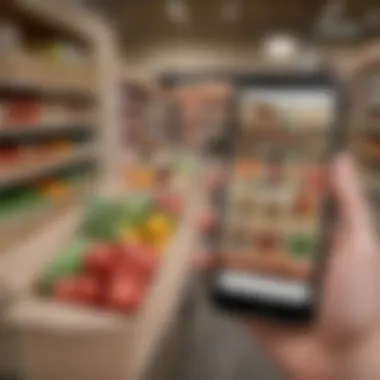Exploring Delivery Options at Trader Joe's: A Comprehensive Guide


Intro
Trader Joe's stands out in the grocery industry, not just for its unique products but also for its approach to customer service. The brand has cultivated an image that blends affordability, quality, and innovation. With the rise of online shopping, customers are looking for convenience. Understanding this, Trader Joe's has adapted its delivery service options to meet the evolving needs of its clientele. This article will explore the delivery methods available at Trader Joe's, diving into the details of third-party services and their in-house solutions.
As grocery delivery becomes more common, it is important to consider how such services affect consumers and the operational dynamics of the store. By examining the technology and logistics behind these delivery options, readers can gain a better understanding of how to utilize these services effectively.
The insights provided will not only help customers navigate Trader Joe's delivery landscape but also equip them to face any potential challenges. Through practical tips and analysis, this guide aims to enhance the shopping experience for all food lovers.
In the sections that follow, we will address key aspects of Trader Joe's delivery services, offering a comprehensive overview and actionable advice.
Prelims to Trader Joe's
Understanding Trader Joe's is essential for grasping the full scope of its delivery services. Trader Joe's stands out in the grocery industry due to its unique approach to product selection, customer interaction, and overall shopping experience. This section will provide a foundation for the subsequent discussion on delivery options available.
History and Evolution
Trader Joe's began its journey in 1967 in Pasadena, California. The founder, Joe Coulombe, initially aimed to create an upscale convenience store. Over the years, it transformed into a beloved grocery store known for its eclectic mix of products and low pricing. The company's evolution reflects a commitment to quality, sustainability, and innovation in the grocery sector.
As the shopping landscape changed, Trader Joe's embraced new strategies such as diversifying its product lines and enhancing customer engagement. This adaptability has allowed it to thrive in a competitive market. Today, Trader Joe's operates more than 500 stores across the United States, making it a significant player in grocery retail.
Product Selection and Philosophy
Trader Joe's prides itself on its distinctive product selection and philosophy. The brand focuses on offering high-quality products at affordable prices. This commitment begins with sourcing items from trusted suppliers and establishing exclusive brands.
The products range from organic foods to unique snacks. Customers can find both familiar brands and exclusive Trader Joe's offerings, often at lower prices than traditional supermarkets. This careful curation creates a shopping experience that is both enjoyable and accessible.
Understanding Delivery Services
In today's fast-paced world, grocery delivery has transformed from a convenience to a necessity for many consumers. This section will explore the significance of understanding delivery services available at Trader Joe's. By grasping the various aspects of these services, customers can make informed decisions to meet their shopping needs. The relevant elements include pricing, service areas, and the ease of using these services in daily life.
Overview of Grocery Delivery
Grocery delivery encompasses a system wherein products are transported from a grocery store to customers' residences. This service has gained traction among consumers preferring the convenience of home shopping. Trader Joe's, known for its unique products, offers various delivery methods that cater to a diverse customer base.
The available delivery options at Trader Joe's typically include:
- In-House Delivery: Trader Joe's may manage deliveries directly through their own team. This option often allows for a more tailored shopping experience, directly connecting customers with their favorite store's products.
- Third-Party Delivery Services: Platforms like DoorDash and Instacart partner with Trader Joe’s to expand their reach. These partnerships enable customers to enjoy the store's offerings without the need to visit in person.
Understanding the implications of each delivery method can help consumers make choices that align with their preferences and lifestyles. Factors such as delivery timeframes, product availability, and customer service aspects must be considered.
Consumer Trends in Grocery Delivery
There has been a noticeable shift in consumer behavior regarding grocery shopping. Research shows that many people now prefer online ordering due to its convenience. The pandemic further accelerated this trend, prompting even those who were hesitant to adapt.
Key trends in grocery delivery include:


- Increased Demand for Convenience: Busy lifestyles have led customers to prioritize time savings. Grocery delivery fits perfectly into this need, allowing shoppers to avoid long lines and heavy traffic.
- Emphasis on Freshness and Quality: Consumers are becoming more adventurous in their food choices, often seeking high-quality and fresh products from stores like Trader Joe's. They want assurance that the items delivered meet their expectations.
- Sustainability Focus: Shoppers are also considering the environmental impact of their purchases. Many seek companies that demonstrate eco-friendly practices in their delivery services.
"Understanding delivery services is not just about convenience; it influences buying decisions and shapes customer loyalty."
As the grocery landscape evolves, Trader Joe's must continually adapt its delivery services to meet changing consumer preferences. This adaptability can represent a crucial differentiator in a competitive marketplace.
Delivery Options at Trader Joe's
Understanding the delivery options available at Trader Joe's is crucial for consumers looking to streamline their grocery shopping. As demands for convenience rise, knowing how Trader Joe's adapts to this landscape can save time and enhance satisfaction. This section delves into both in-house and third-party delivery services, offering insights into how they work and what benefits they bring to the table.
In-House Delivery Services
How it Works
Trader Joe's in-house delivery service operates with a clear focus on efficiency. Customers can order directly from the Trader Joe's website or mobile app. Once the order is placed, a dedicated team picks and packs the items from the store. This streamlined process ensures that produce and perishable items are handled properly, maintaining quality until they reach the customer's door. The unique aspect here is the local touch; deliveries are often made within the same day, allowing for freshness that other services may not provide. However, it may not cover all regions.
Service Areas
The service areas for Trader Joe's in-house delivery are typically limited compared to larger chains. This means that not all customers may have access. Trader Joe's tends to focus on regions with existing store locations, leading to enhanced service quality. While this restriction can make it less accessible for some, it ensures that deliveries are manageable and can be executed efficiently. Areas without a local store may need to rely on third-party options.
Cost Implications
When discussing cost implications, Trader Joe's strives to keep its pricing competitive. Unlike many grocery chains, they often do not charge delivery fees for orders over a certain threshold. This encourages larger purchases, aligning with their business model of offering value. However, customers in regions needing more delivery services may face higher charges if they choose third-party options or if they fall below the specified minimum order value.
Third-Party Delivery Services
Partnerships with Delivery Platforms
Trader Joe's collaborates with several third-party delivery platforms. These partnerships allow customers to order from Trader Joe's through familiar apps like Instacart or DoorDash. This collaboration expands reach, enabling customers who are not in proximity to a store to still access their favorite products. However, these platforms may not offer the same range of items as in-house delivery, which can be a drawback for some.
Advantages and Disadvantages
Using third-party services has distinct advantages and disadvantages. On the plus side, these platforms provide broader availability, making it easier for more customers to enjoy Trader Joe's offerings. Conversely, delivery times can be longer, and fees may vary, depending on the service used. Consumers should weigh these aspects carefully to determine the most effective delivery option for their needs.
Pricing Structures
Pricing structures for third-party delivery can fluctuate significantly. Typically, these services impose delivery fees, service fees, and potential surge pricing during peak hours. Customers may find themselves facing higher costs than ordering directly through Trader Joe's. On the other hand, promotions and discounts are frequently available, which can mitigate these additional costs. Understanding these dynamics can help consumers make informed decisions about their grocery delivery options.
Technological Advances in Delivery Logistics
Understanding technological advances in delivery logistics is crucial for grasping how Trader Joe's optimizes its services. Technology significantly enhances the efficiency and effectiveness of grocery delivery, impacting consumer satisfaction and operational success. Improved logistics technology not only streamlines order processing but also enhances customer experience.
Order Management Systems
Order Management Systems play a key role in the grocery delivery framework at Trader Joe's. These systems facilitate the tracking of customer orders from initiation through fulfillment. By synchronizing inventory levels with customer demand, they ensure that the items selected for delivery are available and accurately represented.
Benefits of these systems include:


- Efficient Processing: Orders are processed quickly, reducing wait times for customers.
- Inventory Control: Real-time data helps in tracking stock levels, minimizing discrepancies between what is offered and what is available.
- Customer Segmentation: These systems can analyze purchasing behaviors, allowing Trader Joe's to tailor offerings based on consumer preferences.
Challenges also arise with Order Management Systems, such as the need for regular updates and training for staff to ensure effective usage. Continuous improvement is vital for maintaining service quality and ensuring customer trust.
Real-Time Tracking Technologies
Real-Time Tracking Technologies enhance transparency in the delivery process. Customers can see where their orders are during every stage, from preparation to delivery. This feature builds confidence and allows customers to plan their schedules more effectively.
The advantages of employing Real-Time Tracking Technologies include:
- Increased Satisfaction: Providing customers with updates mitigates anxiety about order status.
- Feedback Mechanisms: Customers can report issues immediately if they arise, promoting responsive customer service.
- Logistics Optimization: Data collected from tracking systems can lead to improvements in delivery routes and times, making the entire process more efficient.
In summary, advancements in technology profoundly influence the landscape of grocery delivery at Trader Joe's. Through robust Order Management Systems and Real-Time Tracking Technologies, the store can enhance efficiency, improve customer satisfaction, and respond swiftly to changing consumer needs.
Consumer Experience with Delivery
The concept of consumer experience is crucial in understanding how customers interact with delivery services at Trader Joe's. As grocery delivery becomes increasingly popular, the factors that shape user experience are more important than ever. This section dives into the elements that influence how effectively customers can navigate delivery services, ensuring their needs are met with efficiency and satisfaction.
The delivery experience encompasses several components that collectively affect customer satisfaction. These include user interface design, accessibility of the service, and the integration of feedback mechanisms. Each element plays a significant role in how customers perceive and utilize Trader Joe's delivery options.
User Interface and Accessibility
The user interface is the first point of contact for customers when they engage with Trader Joe's delivery services. A streamlined and intuitive UI enhances the shopping experience by making it simple for users to browse products, place orders, and track their deliveries. It is essential that the interface caters to a wide demographic, including tech-savvy individuals as well as those who may not be as familiar with online shopping.
- Simplicity and Clarity: An effective UI emphasizes simple navigation. This means clear categories for different grocery items and straightforward options for filtering selections.
- Mobile Responsiveness: As many users rely on mobile devices, optimizing the mobile version of the platform ensures a convenient shopping experience.
- Visual Appeal: A visually appealing interface can enhance user engagement, encouraging customers to explore more products.
Accessibility also matters significantly. Providing features like voice activation or assistance for visually impaired users can open the services to a broader audience.
Understanding Customer Feedback
Customer feedback serves as a valuable resource for Trader Joe’s in fine-tuning their delivery service. Listening to consumer opinions not only aids in improving service quality but also fosters trust and loyalty.
"Feedback is the breakfast of champions."
- Mechanisms for Review: Trader Joe’s can leverage various platforms for gathering feedback, such as social media or direct surveys sent post-purchase. It allows customers to express their satisfaction or grievances regarding the delivery experience.
- Response to Feedback: Swift and effective responses to customer complaints signal that Trader Joe's values consumer input. A quick resolution can turn a negative experience into a positive one, encouraging future engagements.
- Continuous Improvement: Analyzing feedback trends helps Trader Joe's identify common issues and areas for enhancement, ensuring they adapt to changing consumer expectations.
Understanding these aspects of consumer experience can help Trader Joe's build a robust delivery service that not only meets but exceeds customer expectations.
Challenges in Grocery Delivery
The landscape of grocery delivery is not without its obstacles. For Trader Joe's, a retailer known for its quality and unique offerings, navigating these challenges is vital. Addressing the difficulties in grocery delivery plays a crucial role in ensuring a positive experience for customers. This section analyzes two noteworthy challenges: supply chain issues and customer satisfaction alongside expectations.
Supply Chain Issues
Supply chain management is a cornerstone of grocery delivery systems. Trader Joe's faces pressure to maintain its reputation for freshness and quality. This can be complicated by several factors:


- Vendor Relationships: The quality of products often depends on the suppliers. Delays from these vendors impact product availability.
- Inventory Management: Balancing stock is a delicate task. If inventories run too low, customers may find that their favorite items are unavailable, leading to dissatisfaction.
- Weather and Seasonal Changes: Weather-related disruptions can affect deliveries. For example, transporting perishable goods becomes challenging during adverse conditions.
Ultimately, successful management of the supply chain means that Trader Joe's must remain agile. Adapting to seasonal demands and maintaining robust supplier relationships must be a priority to mitigate these issues.
Customer Satisfaction and Expectations
Understanding customer satisfaction in delivery services is multifaceted. Customers expect speed, reliability, and quality when they order groceries online. Trader Joe's must meet these expectations in various ways:
- Timeliness of Delivery: Customers expect their groceries to arrive within the promised timeframe. Any delays can be frustrating and adversely affect customer loyalty.
- Product Quality: Delivery services must ensure that items received by customers are in excellent condition. This is particularly relevant for fresh produce and dairy items that require careful handling.
- Communication: Keeping customers informed about their order status is essential. Clear communication reduces anxiety and builds trust.
"Customer satisfaction is not just a goal; it's a necessary component of a successful delivery strategy."
Shifting market trends shows more people are inclined towards home delivery options. Therefore, Trader Joe's faces the task of creating a delivery experience that not only meets but exceeds consumer expectations. This will contribute to sustained growth in their delivery service, setting them apart in a competitive landscape.
Tips for Maximizing Your Delivery Experience
Delivery services have emerged as a vital component in the grocery shopping landscape. Understanding how to optimize your experience can lead to enhanced satisfaction and efficiency. This section addresses essential strategies and considerations, giving insights into how customers can navigate through the delivery process at Trader Joe's effectively.
Best Practices for Ordering
When it comes to ordering groceries for delivery, certain best practices can significantly enhance the quality of your experience. Here are some that stand out:
- Review the Inventory Regularly: Trader Joe's is known for its unique and seasonal offerings. Before placing an order, check the store's online inventory to see the latest available items. This can help you avoid disappointment and ensure access to the items you desire.
- Schedule Your Delivery Wisely: Timing can be everything. If possible, opt for delivery during off-peak hours. Early mornings or weekdays may present less crowded situations, resulting in smoother deliveries and fresher items.
- Create a Favorites List: Use the website or app to save frequently purchased items. Having a favorites list can expedite the ordering process, enabling you to make selections quickly without searching anew each time.
- Plan for Substitutions: Trader Joe's may not always have every item in stock. Be prepared for potential substitutions. It’s a good idea to specify acceptable alternatives when ordering, so you get something close to what you wanted.
These practices not only enhance your efficiency but also contribute to a more pleasant delivery experience overall.
Understanding Delivery Fees
Being informed about delivery fees is crucial. Trader Joe's offers various delivery options, many of which come with their own fee structures. Here are key considerations regarding these fees:
- Compare Delivery Options: Understanding the difference between in-house delivery and third-party services like Instacart can influence the costs incurred. In-house options may have lower fees than third-party services; review both to see what suits your budget.
- Be Aware of Minimum Order Requirements: Many delivery services requires a minimum order amount to qualify for delivery. Make sure you meet these requirements to avoid unforeseen costs!
- Watch for Promotions: Occasionally, Trader Joe's may offer promotions or discounts on delivery fees. Keeping an eye on their policies and subscribing to newsletters can provide opportunities for savings.
- Transparency in Fees: Always check for clarity in fee structures at checkout, as additional charges like service fees and tips might apply. Being vigilant about these details can help prevent surprises and ensure a satisfactory transaction.
By understanding and navigating delivery fees effectively, you set yourself up for an enhanced shopping experience at Trader Joe's.
Epilogue: The Future of Delivery at Trader Joe's
In recent years, the landscape of grocery shopping has seen significant changes, and Trader Joe's is no exception. The focus on delivery methods is not just a trend but a necessary evolution to meet consumer needs. Understanding the future of delivery at Trader Joe's involves recognizing several key elements.
First, this topic reflects the store's commitment to customer satisfaction. As consumers increasingly value convenience, Trader Joe's must adapt its delivery options to cater to those preferences. Moreover, the ever-changing technology landscape means that Trader Joe's needs to stay ahead of the curve. By investing in modern delivery systems, they can ensure efficient service and accuracy in fulfilling orders.
Trends Shaping the Delivery Landscape
The grocery delivery industry is being shaped by several trends. The increase in online shopping, especially prompted by the pandemic, has in turn led to a rise in demand for delivery services. Several factors are central to this evolution:
- Technological Integration: The growth of mobile apps and websites that support easy ordering has changed how consumers shop.
- Personalization: Brands are beginning to offer tailored shopping experiences. Consumers appreciate suggestions based on previous purchases.
- Sustainability: Many customers prefer companies that prioritize eco-friendly practices in their operations.
Prospective Developments and Innovations
As Trader Joe's looks to the future, several innovations may play a crucial role in shaping its delivery services. Here are a few possible developments:
- Enhanced Real-Time Tracking: Continued improvements in tracking technology will allow customers to know exactly when to expect their orders.
- Automated Fulfillment Centers: Introducing automation could streamline the packing process, thereby reducing delivery times.
- Expanded Delivery Partnerships: Collaborating with additional delivery platforms may improve reach and flexibility for customers.
In summary, the future of delivery at Trader Joe's hinges not only on current consumer behavior but also on how effectively the company can innovate and integrate these trends into its operations. As customers continue to prioritize convenience and sustainability, Trader Joe's has the chance to redefine its delivery model. This evolution holds the potential to enhance the customer experience significantly.
"The grocery delivery landscape is evolving rapidly, and Trader Joe's has the opportunity to lead in this domain by prioritizing customer needs and embracing innovations."
By focusing on these elements, Trader Joe's can ensure they remain a beloved retail choice for food lovers of all ages.







